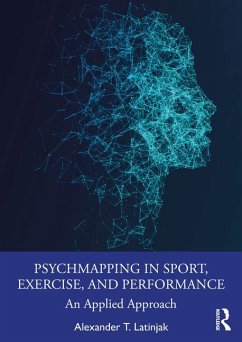- Broschiertes Buch
- Merkliste
- Auf die Merkliste
- Bewerten Bewerten
- Teilen
- Produkt teilen
- Produkterinnerung
- Produkterinnerung
This book introduces PsychMapping, a unique model that visually and philosophically guides readers through the complexities of human behaviour. The holistic approach reveals how different psychological aspects interact and influence each other.
Andere Kunden interessierten sich auch für
![Psychmapping in Sport, Exercise, and Performance Psychmapping in Sport, Exercise, and Performance]() Alexander T LatinjakPsychmapping in Sport, Exercise, and Performance142,99 €
Alexander T LatinjakPsychmapping in Sport, Exercise, and Performance142,99 €![Cognitive Behaviour Therapy in Sport and Performance Cognitive Behaviour Therapy in Sport and Performance]() Paul MccarthyCognitive Behaviour Therapy in Sport and Performance175,99 €
Paul MccarthyCognitive Behaviour Therapy in Sport and Performance175,99 €![Cognitive Behaviour Therapy in Sport and Performance Cognitive Behaviour Therapy in Sport and Performance]() Paul McCarthyCognitive Behaviour Therapy in Sport and Performance41,99 €
Paul McCarthyCognitive Behaviour Therapy in Sport and Performance41,99 €![Beyond Marginal Gains Beyond Marginal Gains]() Rob MugglestoneBeyond Marginal Gains34,99 €
Rob MugglestoneBeyond Marginal Gains34,99 €![Sport, Exercise, and Performance Psychology Sport, Exercise, and Performance Psychology]() Sport, Exercise, and Performance Psychology91,99 €
Sport, Exercise, and Performance Psychology91,99 €![The Athlete and Their Mechanisms of Defense The Athlete and Their Mechanisms of Defense]() Tom FerraroThe Athlete and Their Mechanisms of Defense35,99 €
Tom FerraroThe Athlete and Their Mechanisms of Defense35,99 €![Learning from Serial Winning Coaches Learning from Serial Winning Coaches]() Cliff MallettLearning from Serial Winning Coaches40,99 €
Cliff MallettLearning from Serial Winning Coaches40,99 €-
-
-
This book introduces PsychMapping, a unique model that visually and philosophically guides readers through the complexities of human behaviour. The holistic approach reveals how different psychological aspects interact and influence each other.
Hinweis: Dieser Artikel kann nur an eine deutsche Lieferadresse ausgeliefert werden.
Hinweis: Dieser Artikel kann nur an eine deutsche Lieferadresse ausgeliefert werden.
Produktdetails
- Produktdetails
- Verlag: Taylor & Francis Ltd
- Seitenzahl: 272
- Erscheinungstermin: 12. November 2024
- Englisch
- Abmessung: 245mm x 173mm x 18mm
- Gewicht: 506g
- ISBN-13: 9781032592541
- ISBN-10: 1032592540
- Artikelnr.: 70942111
- Herstellerkennzeichnung
- Libri GmbH
- Europaallee 1
- 36244 Bad Hersfeld
- gpsr@libri.de
- Verlag: Taylor & Francis Ltd
- Seitenzahl: 272
- Erscheinungstermin: 12. November 2024
- Englisch
- Abmessung: 245mm x 173mm x 18mm
- Gewicht: 506g
- ISBN-13: 9781032592541
- ISBN-10: 1032592540
- Artikelnr.: 70942111
- Herstellerkennzeichnung
- Libri GmbH
- Europaallee 1
- 36244 Bad Hersfeld
- gpsr@libri.de
Alexander T. Latinjak is an Associate Professor of Sport and Exercise Psychology at the University of Suffolk, UK and the founder of the PsychMapping movement. A prominent figure in the scientific community, he publishes regularly in leading specialist journals and serves on the editorial boards of various academic publications. With over 20 years of applied experience, Alexander has worked extensively in talent development and elite-level environments, bringing practical insights to his research and teaching.
PART I
The PsychMapping perspective
1 PsychMapping and sport, exercise, and performance psychology
PART II
What are people made of?
2 Descriptive traits: Who the heck are you?
3 Descriptive states: What on earth is the matter with you today?
4 The relation between descriptive states and traits: That experience
totally changed me!
5 The externalized self: Behaviour, performance, and environmental
interaction
Case 1 Self-reflexion exercises to understand clients' identity and
experiences
PART III
All that what surrounds people
6 External factors: There is always something or someone to blame!
7 Interpersonal PsychMapping model: From individual focus to collective
insight
Case 2 A team mapping analysis based on the interpersonal PsychMapping
model
PART IV
The major processes that shape us
8 External perception: It's not you, it's me
9 Self-regulation: Get your act together!
Case 3 Building self-knowledge, improving self-regulation
PART V
Applied practice
10 Indirect interventions: You might never know what I have done for you
11 Working with individuals: So much more than interventions
PART VI
The basic PsychMapping exercise
12 The PsychMapping exercise: Not really an interview guide
13 The PsychMapping exercise construction manual
14 Analysis: Don't take this the wrong way
The PsychMapping perspective
1 PsychMapping and sport, exercise, and performance psychology
PART II
What are people made of?
2 Descriptive traits: Who the heck are you?
3 Descriptive states: What on earth is the matter with you today?
4 The relation between descriptive states and traits: That experience
totally changed me!
5 The externalized self: Behaviour, performance, and environmental
interaction
Case 1 Self-reflexion exercises to understand clients' identity and
experiences
PART III
All that what surrounds people
6 External factors: There is always something or someone to blame!
7 Interpersonal PsychMapping model: From individual focus to collective
insight
Case 2 A team mapping analysis based on the interpersonal PsychMapping
model
PART IV
The major processes that shape us
8 External perception: It's not you, it's me
9 Self-regulation: Get your act together!
Case 3 Building self-knowledge, improving self-regulation
PART V
Applied practice
10 Indirect interventions: You might never know what I have done for you
11 Working with individuals: So much more than interventions
PART VI
The basic PsychMapping exercise
12 The PsychMapping exercise: Not really an interview guide
13 The PsychMapping exercise construction manual
14 Analysis: Don't take this the wrong way
PART I
The PsychMapping perspective
1 PsychMapping and sport, exercise, and performance psychology
PART II
What are people made of?
2 Descriptive traits: Who the heck are you?
3 Descriptive states: What on earth is the matter with you today?
4 The relation between descriptive states and traits: That experience totally changed me!
5 The externalized self: Behaviour, performance, and environmental interaction
Case 1 Self-reflexion exercises to understand clients' identity and experiences
PART III
All that what surrounds people
6 External factors: There is always something or someone to blame!
7 Interpersonal PsychMapping model: From individual focus to collective insight
Case 2 A team mapping analysis based on the interpersonal PsychMapping model
PART IV
The major processes that shape us
8 External perception: It's not you, it's me
9 Self-regulation: Get your act together!
Case 3 Building self-knowledge, improving self-regulation
PART V
Applied practice
10 Indirect interventions: You might never know what I have done for you
11 Working with individuals: So much more than interventions
PART VI
The basic PsychMapping exercise
12 The PsychMapping exercise: Not really an interview guide
13 The PsychMapping exercise construction manual
14 Analysis: Don't take this the wrong way
The PsychMapping perspective
1 PsychMapping and sport, exercise, and performance psychology
PART II
What are people made of?
2 Descriptive traits: Who the heck are you?
3 Descriptive states: What on earth is the matter with you today?
4 The relation between descriptive states and traits: That experience totally changed me!
5 The externalized self: Behaviour, performance, and environmental interaction
Case 1 Self-reflexion exercises to understand clients' identity and experiences
PART III
All that what surrounds people
6 External factors: There is always something or someone to blame!
7 Interpersonal PsychMapping model: From individual focus to collective insight
Case 2 A team mapping analysis based on the interpersonal PsychMapping model
PART IV
The major processes that shape us
8 External perception: It's not you, it's me
9 Self-regulation: Get your act together!
Case 3 Building self-knowledge, improving self-regulation
PART V
Applied practice
10 Indirect interventions: You might never know what I have done for you
11 Working with individuals: So much more than interventions
PART VI
The basic PsychMapping exercise
12 The PsychMapping exercise: Not really an interview guide
13 The PsychMapping exercise construction manual
14 Analysis: Don't take this the wrong way
PART I
The PsychMapping perspective
1 PsychMapping and sport, exercise, and performance psychology
PART II
What are people made of?
2 Descriptive traits: Who the heck are you?
3 Descriptive states: What on earth is the matter with you today?
4 The relation between descriptive states and traits: That experience
totally changed me!
5 The externalized self: Behaviour, performance, and environmental
interaction
Case 1 Self-reflexion exercises to understand clients' identity and
experiences
PART III
All that what surrounds people
6 External factors: There is always something or someone to blame!
7 Interpersonal PsychMapping model: From individual focus to collective
insight
Case 2 A team mapping analysis based on the interpersonal PsychMapping
model
PART IV
The major processes that shape us
8 External perception: It's not you, it's me
9 Self-regulation: Get your act together!
Case 3 Building self-knowledge, improving self-regulation
PART V
Applied practice
10 Indirect interventions: You might never know what I have done for you
11 Working with individuals: So much more than interventions
PART VI
The basic PsychMapping exercise
12 The PsychMapping exercise: Not really an interview guide
13 The PsychMapping exercise construction manual
14 Analysis: Don't take this the wrong way
The PsychMapping perspective
1 PsychMapping and sport, exercise, and performance psychology
PART II
What are people made of?
2 Descriptive traits: Who the heck are you?
3 Descriptive states: What on earth is the matter with you today?
4 The relation between descriptive states and traits: That experience
totally changed me!
5 The externalized self: Behaviour, performance, and environmental
interaction
Case 1 Self-reflexion exercises to understand clients' identity and
experiences
PART III
All that what surrounds people
6 External factors: There is always something or someone to blame!
7 Interpersonal PsychMapping model: From individual focus to collective
insight
Case 2 A team mapping analysis based on the interpersonal PsychMapping
model
PART IV
The major processes that shape us
8 External perception: It's not you, it's me
9 Self-regulation: Get your act together!
Case 3 Building self-knowledge, improving self-regulation
PART V
Applied practice
10 Indirect interventions: You might never know what I have done for you
11 Working with individuals: So much more than interventions
PART VI
The basic PsychMapping exercise
12 The PsychMapping exercise: Not really an interview guide
13 The PsychMapping exercise construction manual
14 Analysis: Don't take this the wrong way
PART I
The PsychMapping perspective
1 PsychMapping and sport, exercise, and performance psychology
PART II
What are people made of?
2 Descriptive traits: Who the heck are you?
3 Descriptive states: What on earth is the matter with you today?
4 The relation between descriptive states and traits: That experience totally changed me!
5 The externalized self: Behaviour, performance, and environmental interaction
Case 1 Self-reflexion exercises to understand clients' identity and experiences
PART III
All that what surrounds people
6 External factors: There is always something or someone to blame!
7 Interpersonal PsychMapping model: From individual focus to collective insight
Case 2 A team mapping analysis based on the interpersonal PsychMapping model
PART IV
The major processes that shape us
8 External perception: It's not you, it's me
9 Self-regulation: Get your act together!
Case 3 Building self-knowledge, improving self-regulation
PART V
Applied practice
10 Indirect interventions: You might never know what I have done for you
11 Working with individuals: So much more than interventions
PART VI
The basic PsychMapping exercise
12 The PsychMapping exercise: Not really an interview guide
13 The PsychMapping exercise construction manual
14 Analysis: Don't take this the wrong way
The PsychMapping perspective
1 PsychMapping and sport, exercise, and performance psychology
PART II
What are people made of?
2 Descriptive traits: Who the heck are you?
3 Descriptive states: What on earth is the matter with you today?
4 The relation between descriptive states and traits: That experience totally changed me!
5 The externalized self: Behaviour, performance, and environmental interaction
Case 1 Self-reflexion exercises to understand clients' identity and experiences
PART III
All that what surrounds people
6 External factors: There is always something or someone to blame!
7 Interpersonal PsychMapping model: From individual focus to collective insight
Case 2 A team mapping analysis based on the interpersonal PsychMapping model
PART IV
The major processes that shape us
8 External perception: It's not you, it's me
9 Self-regulation: Get your act together!
Case 3 Building self-knowledge, improving self-regulation
PART V
Applied practice
10 Indirect interventions: You might never know what I have done for you
11 Working with individuals: So much more than interventions
PART VI
The basic PsychMapping exercise
12 The PsychMapping exercise: Not really an interview guide
13 The PsychMapping exercise construction manual
14 Analysis: Don't take this the wrong way








